
7 Must-Read Coming Out YA Novels: A Newbie’s Guide
New to the coming of gayge genre? Looking to read or buy some of the best examples of the queer coming out YA genre? This list is for you!
Queer YA novelist Malinda Lo describes the general formula of the YA coming out / of age novel as: “character struggles with homosexual desire in a homophobic world; character falls in tormented, transformative love; character is unceremoniously outed. Boom. In the fallout, things usually get a lot worse before they get better.” There are certainly plenty of novels that follow this model to a T, and they can be heavy and intense. But the great thing in recent queer YA is that even when queer authors are writing in the LGB teen coming out genre, they’re doing new and exciting things that subvert and challenge the genre conventions. The following queer YA coming out novels are some of my personal favorites that sit firmly within this YA subgenre while at the same time rising above its generic formula and expectations. For any lover of queer YA or a library wanting to have a solid base of LGBTQ YA books, these seven novels are must-haves.
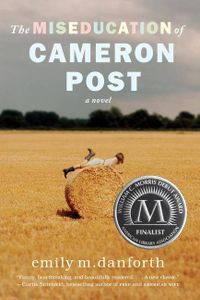 The Miseducation of Cameron Post by Emily M. Danforth
The Miseducation of Cameron Post by Emily M. Danforth
Danforth’s debut is a great example of a YA coming of age / coming out novel that follows the general trajectory of these stories while also transcending the tropes. Set in late 1980s/early 1990s rural Montana, The Miseducation of Cameron Post starts with 12-year-old Cameron at the moment when her first kiss with a girl coincides with her parents’ death in a car accident. Horrifically, her first thought at becoming an orphan is relief, as she thinks her parents will never know she’s a lesbian. The novel follows her coming out process as it is inextricably entangled with her grief. Cameron has other relationships with girls as she grows older, and one day, as is usual in these narratives, someone finds out and bad things happen. Cameron is sent to a gay conversion camp, where, ironically, she finds her first community of queer teens like herself. Eventually, she emerges even more committed to her sexual identity. Danforth makes this novel stand out from the rest with her slow, deliberate pace and a slightly more distant and less angst-ridden voice than found in a lot of YA novels. She also avoids moralizing and embraces complications, especially in the way she treats the “ex-gay” camp. It’s the kind of YA novel (queer) teens deserve, one that doesn’t talk down to them or water down complexity. (FYI though: the treatment of a secondary queer Indigenous character is problematic.)
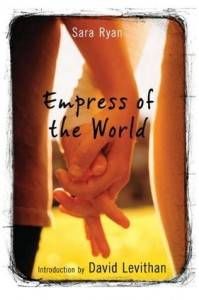 Empress of the World by Sara Ryan
Empress of the World by Sara Ryan
Empress of the World was a groundbreaking coming out / coming of age story when it was first published in 2001 because it focused on a main character who was bisexual. Set at a summer school program for “gifted” teens, the story follows Nicola Lancaster, or Nic, who’s obsessed with anthropology. Nic’s first-person perspective is full of her “field notes” about her new, quirky friends: Katrina (an outspoken computer hacker), Isaac (actual “nice” guy), Kevin (a spacey musical composer), and Battle, a beautiful dancer Nic is immediately drawn to. Ryan develops Battle and Nic’s friendship and growing romantic relationship while she traces Nic’s confusion about her sexual identity. Before meeting Battle, Nic had only ever been attracted to boys. Now that she has a girlfriend, she’s unsure what to call herself. True to the confusing experiences of many young people whose sexual identities fall outside the labels straight and gay, Nic suffers under the pressure of deciding whether she is lesbian or straight, without even realizing that bisexual is an option. While the focus on the issue of sexual identity to the exclusion of a truly compelling plot makes Empress of the World a somewhat standard coming out novel, the importance of the trailblazing bisexual protagonist shouldn’t be underestimated.
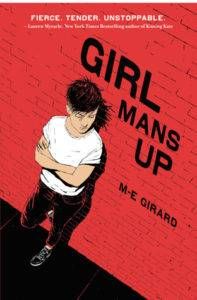 Girl Mans Up by M-E Girard
Girl Mans Up by M-E Girard
An important intervention in the subgenre of coming of age YA books about LGB characters, Girl Mans Up is about a young woman named Penelope, aka Pen, who already knows she’s a lesbian. In particular, she’s a butch/masculine lesbian; her gender expression is in many ways the focus of the narrative, rather than her sexual orientation. What she works toward over the course of the book is demanding recognition and respect from everyone else around her for who she is, cutting out people who won’t, and making new connections with people who will. It’s a quiet journey, without the fanfare of other coming of age YA. Along the way she develops a healthy romantic and sexual relationship with a girl named Blake. Pen is a refreshingly real character who makes a lot of mistakes and is not always likable. The characterization of Pen is rich and dynamic, especially as Girard investigates Pen emulating the toxic masculinity of her guy friends as she tries to figure out how to express her gender without oppressing others. Some of the other characters are less dynamic, especially Blake, who is perhaps a little too perfect. Pen’s parents are similarly one-dimensional on the other end of the spectrum as villains. But the book is from Pen’s perspective, so this reductive characterization makes some sense. Girl Mans Up is a subtle book that resists flashy portrayals of instant change brought on by dramatic events, making it a testament to an authentic, gradual coming of age process.
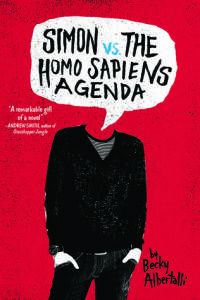 Simon Vs. the Homo Sapiens Agenda by Becky Albertalli
Simon Vs. the Homo Sapiens Agenda by Becky Albertalli
Amidst the sea of queer YA coming of age novels that are dark and full of angst and homophobia-fueled obstacles, there is fun, fluffy, funny, sweet Simon Vs. the Homo Sapiens Agenda. The novel’s main character is 16-year-old Simon Spier, a musical theatre geek who knows he’s gay but is not out to anyone at his school. When he meets another boy from his class in an anonymous Tumblr group, he and the mysteriously named “Blue” start emailing. Before Simon knows it, he and Blue are flirting and falling in love online. But when an email falls into the wrong hands, both Simon’s sexuality and the secret identity of Blue are at stake: class clown Martin is blackmailing Simon into being his wingman. Simon’s always been the kind of guy who’s averse to change, the kind of person who likes to stay in his comfort zone. Is he willing to step outside his bubble of safety in order to take charge of his own coming out, stay true to himself, and pursue a real relationship with an awesome, adorable guy? Albertalli’s authentic, charming dialogue for Simon and Blue, as well as Simon’s inner monologue, perfectly capture the trepidation, awkwardness, and excitement of coming out. She also admirably and seamlessly integrates racially diverse characters. The lack of physical violence and explicit homophobia is a welcome change in this romance-focused coming of age story.
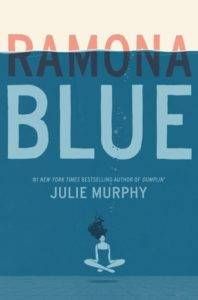 Ramona Blue by Julie Murphy
Ramona Blue by Julie Murphy
Ramona Blue is a trailblazing YA book about a bisexual character. The trend for stories featuring bisexual protagonists—as exemplified in Empress of the World—is that characters move from assuming a straight identity to a bisexual one. In Ramona Blue, the title character Ramona moves from thinking of herself as a lesbian to knowing her sexuality is more fluid. Ramona lives in rural Mississippi in a trailer with her family: her pregnant older sister, her unreliable mom, and her well-meaning but always missing the mark dad. They’ve lived in a trailer ever since Hurricane Katrina destroyed their home. Ramona stands out in her town as the girl who’s over six feet tall, has blue hair, and who’s out as queer. She feels a lot of responsibility for her family, even juggling multiple jobs to help out with finances, and struggles to balance their needs with her own. The return of her childhood friend Freddie is a welcome distraction from her obligations, but when her feelings for him turn romantic, Ramona’s confidence that she knows exactly who she is and what her life is going to be like are shattered. It’s the kind of coming of age story that any young person who realizes the world (and themselves) are a lot more complicated than they initially thought will be able to relate to. Ramona Blue is a refreshing coming of age narrative that emphasizes part of growing up is knowing that you don’t have everything figured out and learning to be okay with that.
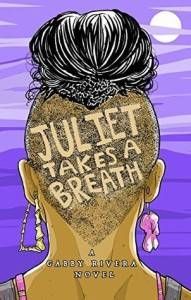 Juliet Takes a Breath by Gabby Rivera
Juliet Takes a Breath by Gabby Rivera
With a protagonist slightly older than in most YA novels, Juliet Takes a Breath centres on 19-year-old Juliet, a young Puerto Rican woman who is leaving her home in the Bronx for the first time. She’s just come out as a lesbian to her family, and isn’t sure if her mom is ever going to speak to her again. Plus, she’s off across the country to live in Portland, OR, for the summer to be an intern for the famous author of her new favourite book about feminism. Juliet’s time in Portland turns out to be educational in more ways than she even expected, as she learns that her mentor’s brand of feminism is very white women–centric. At the same time, Juliet learns about the community of queer and trans people of colour that she has just become a part of and even finds a sort-of girlfriend! Unfortunately the narrative suffers a bit from a tendency to tell rather than show vis-à-vis action and character and too many didactic turns. On the sentence level, however, first-time novelist Rivera has a lot of success. The parodies of white feminism are particularly hilarious and many lyrical turns of phrase are lovely. Despite its flaws, this book is an important intervention for queer people of colour into the coming of age / coming out genre that so often only features white characters.
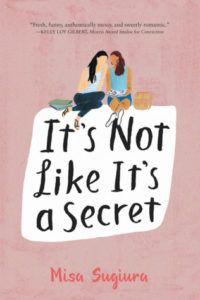 It’s Not Like It’s A Secret by Misa Sugiura
It’s Not Like It’s A Secret by Misa Sugiura
In this lesbian coming of age story, 16-year-old Sana Kiyohara is keeping a lot of secrets: she never tells her friends when they hurt her feelings, she’s pretty sure her dad is having an affair, and she might have a crush on her best friend, who’s a girl. When her family moves to California, this might be the fresh start Sana needs to stop keeping secrets and start telling the truth. She becomes especially motivated after meeting Jamie Ramirez, a smart, beautiful girl who’s different from anyone Sana has ever met. Would it be the end of the world to come out and admit she wants to date a girl? As Sana moves closer to telling her own truth, a lot of other stuff gets in the way: her and Jamie’s friends don’t really get along, her dad’s affair becomes increasingly obvious, and a nice guy named Caleb seems to have romantic feelings for her. Is it telling the truth that’s the hard part, or what comes after? Sugiura excels at tackling tough topics like racism between different non-white communities and the unique struggles of Japanese American queer young people. The inclusion of poetry—which Jamie and Sana share with each other—adds an unexpected element and is a nice way to break up the prose. Like Ramona Blue and The Miseducation of Cameron Post, It’s Not Like It’s a Secret is a coming of age story that isn’t afraid to embrace complexity and leave some questions unanswered.
These seven books are obviously just the beginning of queer coming out YA books. Check out this Book Riot list of 100 Must-Read LGBTQIA YA Books for more!













